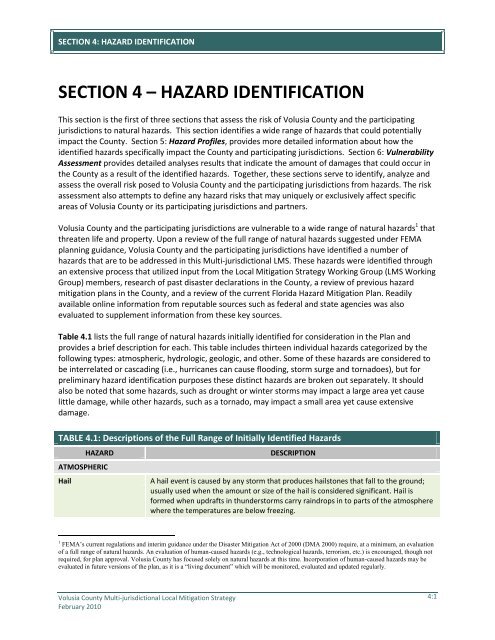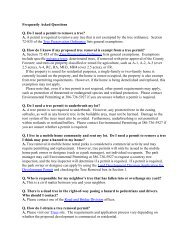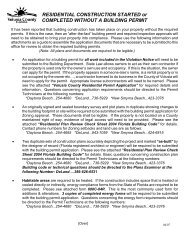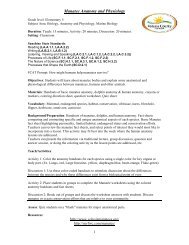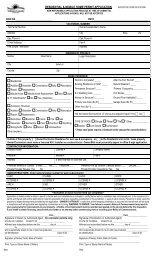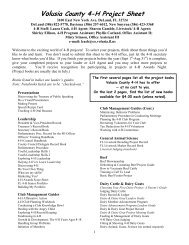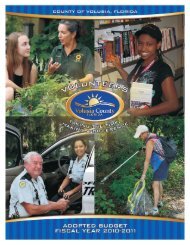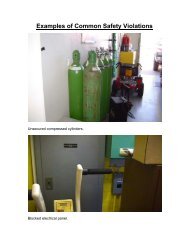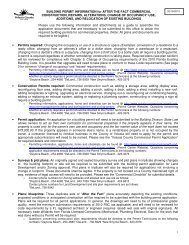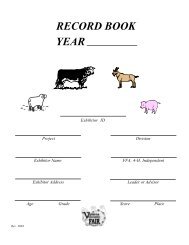Local mitigation strategy (LMS) - Volusia County Government
Local mitigation strategy (LMS) - Volusia County Government
Local mitigation strategy (LMS) - Volusia County Government
You also want an ePaper? Increase the reach of your titles
YUMPU automatically turns print PDFs into web optimized ePapers that Google loves.
SECTION 4: HAZARD IDENTIFICATIONSECTION 4 – HAZARD IDENTIFICATIONThis section is the first of three sections that assess the risk of <strong>Volusia</strong> <strong>County</strong> and the participatingjurisdictions to natural hazards. This section identifies a wide range of hazards that could potentiallyimpact the <strong>County</strong>. Section 5: Hazard Profiles, provides more detailed information about how theidentified hazards specifically impact the <strong>County</strong> and participating jurisdictions. Section 6: VulnerabilityAssessment provides detailed analyses results that indicate the amount of damages that could occur inthe <strong>County</strong> as a result of the identified hazards. Together, these sections serve to identify, analyze andassess the overall risk posed to <strong>Volusia</strong> <strong>County</strong> and the participating jurisdictions from hazards. The riskassessment also attempts to define any hazard risks that may uniquely or exclusively affect specificareas of <strong>Volusia</strong> <strong>County</strong> or its participating jurisdictions and partners.<strong>Volusia</strong> <strong>County</strong> and the participating jurisdictions are vulnerable to a wide range of natural hazards 1 thatthreaten life and property. Upon a review of the full range of natural hazards suggested under FEMAplanning guidance, <strong>Volusia</strong> <strong>County</strong> and the participating jurisdictions have identified a number ofhazards that are to be addressed in this Multi-jurisdictional <strong>LMS</strong>. These hazards were identified throughan extensive process that utilized input from the <strong>Local</strong> Mitigation Strategy Working Group (<strong>LMS</strong> WorkingGroup) members, research of past disaster declarations in the <strong>County</strong>, a review of previous hazard<strong>mitigation</strong> plans in the <strong>County</strong>, and a review of the current Florida Hazard Mitigation Plan. Readilyavailable online information from reputable sources such as federal and state agencies was alsoevaluated to supplement information from these key sources.Table 4.1 lists the full range of natural hazards initially identified for consideration in the Plan andprovides a brief description for each. This table includes thirteen individual hazards categorized by thefollowing types: atmospheric, hydrologic, geologic, and other. Some of these hazards are considered tobe interrelated or cascading (i.e., hurricanes can cause flooding, storm surge and tornadoes), but forpreliminary hazard identification purposes these distinct hazards are broken out separately. It shouldalso be noted that some hazards, such as drought or winter storms may impact a large area yet causelittle damage, while other hazards, such as a tornado, may impact a small area yet cause extensivedamage.TABLE 4.1: Descriptions of the Full Range of Initially Identified HazardsHAZARDATMOSPHERICHailDESCRIPTIONA hail event is caused by any storm that produces hailstones that fall to the ground;usually used when the amount or size of the hail is considered significant. Hail isformed when updrafts in thunderstorms carry raindrops in to parts of the atmospherewhere the temperatures are below freezing.1 FEMA’s current regulations and interim guidance under the Disaster Mitigation Act of 2000 (DMA 2000) require, at a minimum, an evaluationof a full range of natural hazards. An evaluation of human-caused hazards (e.g., technological hazards, terrorism, etc.) is encouraged, though notrequired, for plan approval. <strong>Volusia</strong> <strong>County</strong> has focused solely on natural hazards at this time. Incorporation of human-caused hazards may beevaluated in future versions of the plan, as it is a “living document” which will be monitored, evaluated and updated regularly.<strong>Volusia</strong> <strong>County</strong> Multi-jurisdictional <strong>Local</strong> Mitigation StrategyFebruary 20104:1


